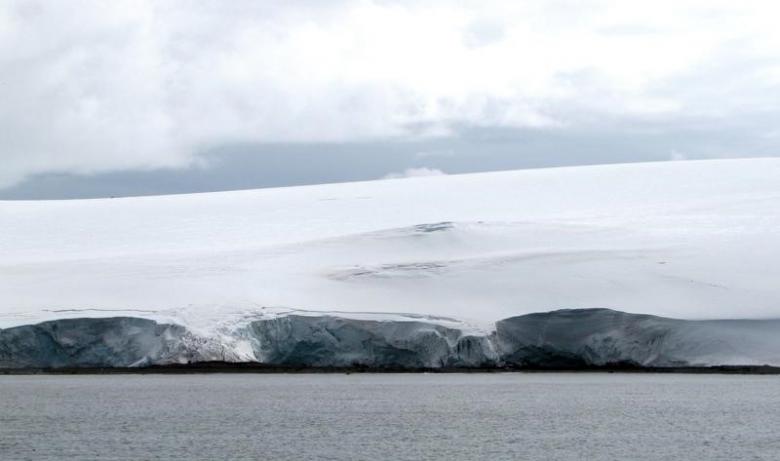Sea Ice around Antarctica Hits Record Low, Preliminary U.S. Data Show
ENVIRONMENT, 20 Feb 2017
Alister Doyle | Reuters – TRANSCEND Media Service

Cracks are seen on the Fourcade glacier near Argentina’s Carlini Base in Antarctica, January 12, 2017.
REUTERS/Nicolas Misculin
Sea ice around Antarctica has shrunk to the smallest annual extent on record after years of resisting a trend of man-made global warming, preliminary U.S. satellite data showed on Tuesday [14 Feb 2017].
Ice floating around the frozen continent usually melts to its smallest for the year around the end of February, the southern hemisphere summer, before expanding again as the autumn chill sets in.
This year, sea ice extent contracted to 2.287 million square kilometers (883,015 square miles) on Feb. 13, according to daily data from the U.S. National Snow and Ice Data Center (NSIDC).
That extent is a fraction smaller than a previous low of 2.290 million sq kms (884,173 square miles) recorded on Feb. 27, 1997, in satellite records dating back to 1979.
Mark Serreze, director of the NSIDC, said he would wait for a few days’ more measurements to confirm the record low.
“But unless something funny happens, we’re looking at a record minimum in Antarctica. Some people say it’s already happened,” he told Reuters. “We tend to be conservative by looking at five-day running averages.”
In many recent years, the average extent of sea ice around Antarctica has tended to expand despite the overall trend of global warming, blamed on a build-up of greenhouse gases in the atmosphere, mainly from burning fossil fuels.
People skeptical of mainstream findings by climate scientists have often pointed to Antarctic sea ice as evidence against global warming. Some climate scientists have linked the paradoxical expansion to shifts in winds and ocean currents.
“We’ve always thought of the Antarctic as the sleeping elephant starting to stir. Well, maybe it’s starting to stir now,” Serreze said.
World average temperatures climbed to a record high in 2016 for the third year in a row. Climate scientists say warming is causing more extreme days of heat, downpours and is nudging up global sea levels.
At the other end of the planet, ice covering the Arctic Ocean has set repeated lows in recent years.
In the northern winter, sea ice is growing in winter and is at the smallest extent for mid-February, at 13.927 million sq kms (5.377 million square miles).
Combined, the extent of sea ice at both ends of the planet is about 2 million sq kms (772,200 square miles) less than the 1981-2010 averages for mid-February, roughly the size of Mexico or Saudi Arabia.
_______________________________
Also In Global Energy News:
- Climate doubter Pruitt takes EPA reins as Trump targets regulations
- India still keen to buy Westinghouse reactors despite Toshiba meltdown
Reporting by Alister Doyle, editing by Larry King.
DISCLAIMER: The statements, views and opinions expressed in pieces republished here are solely those of the authors and do not necessarily represent those of TMS. In accordance with title 17 U.S.C. section 107, this material is distributed without profit to those who have expressed a prior interest in receiving the included information for research and educational purposes. TMS has no affiliation whatsoever with the originator of this article nor is TMS endorsed or sponsored by the originator. “GO TO ORIGINAL” links are provided as a convenience to our readers and allow for verification of authenticity. However, as originating pages are often updated by their originating host sites, the versions posted may not match the versions our readers view when clicking the “GO TO ORIGINAL” links. This site contains copyrighted material the use of which has not always been specifically authorized by the copyright owner. We are making such material available in our efforts to advance understanding of environmental, political, human rights, economic, democracy, scientific, and social justice issues, etc. We believe this constitutes a ‘fair use’ of any such copyrighted material as provided for in section 107 of the US Copyright Law. In accordance with Title 17 U.S.C. Section 107, the material on this site is distributed without profit to those who have expressed a prior interest in receiving the included information for research and educational purposes. For more information go to: http://www.law.cornell.edu/uscode/17/107.shtml. If you wish to use copyrighted material from this site for purposes of your own that go beyond ‘fair use’, you must obtain permission from the copyright owner.